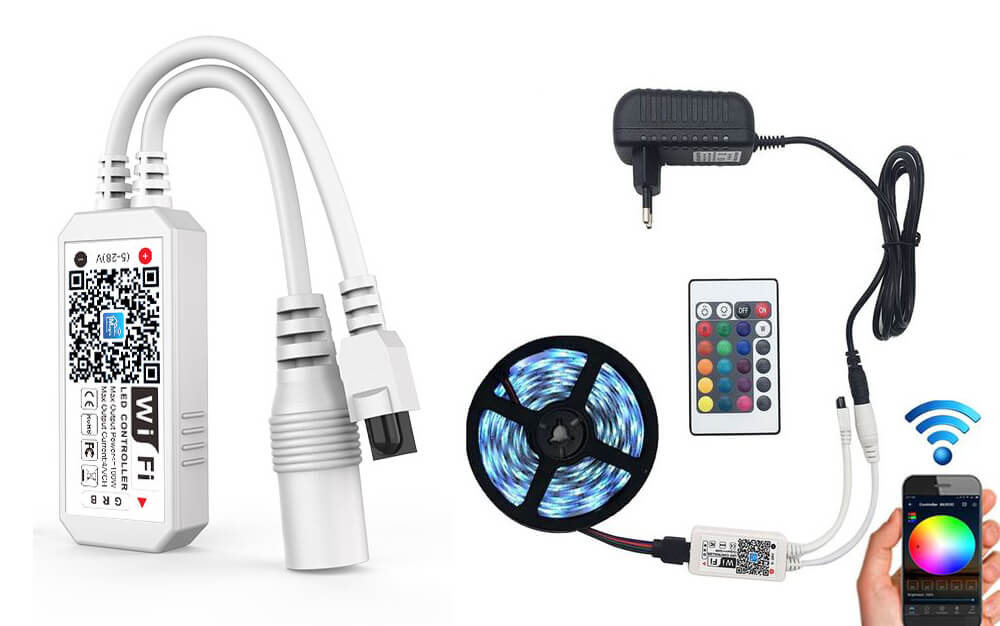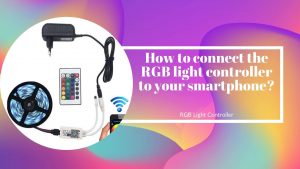LED strip lights controllers connect to LED strips to unlock smart capabilities that elevate illumination far beyond basic lighting. Controllers transform static LED strips into dynamic fixtures capable of intricately mixing colors, creating captivating lighting effects, responding to music, and integrating automation through app and voice controls. This comprehensive guide will explore the different types of LED strip light controllers available, the many benefits they provide, and how they help LED strips reach their full potential for customizing state-of-the-art lighting experiences.

Table of Contents
ToggleTypes of LED Strip Lights Controllers and Remotes
LED strip lights controllers communicate with connected LED strips to control lighting effects and capabilities. They come in several main types:
RGB Controllers
RGB refers to the red, green and blue color model where colors are produced by mixing variable intensities of the three primary hues. RGB strip controllers use this additive color mixing principle to allow adjusting the level of red, green and blue LED channels independently to create any desired color.
Controller Remote Control Types
RGB controllers feature various remote communication protocols to send control signals to the LED strips:
- Infrared (IR) Remotes – Infrared remotes provide the most economical control option. They have a limited short-range under 5 meters and require line-of-sight to the sensor on the controller.
- Radio Frequency (RF) Remotes – RF remotes use radio waves allowing increased range up to 30 meters without line-of-sight requirements for more flexibility.
- WiFi Controllers – WiFi-enabled controllers connect to a home’s wireless network to allow app and voice control through smart devices connected on the same network.
- Bluetooth Controllers – Bluetooth controllers sync directly with smartphones and tablets via Bluetooth without the need for a hub or router.
As smart home technology improves, WiFi and Bluetooth controllers are becoming more popular for their expansive features and convenience.
Benefits of Using LED Strip Lights Controllers
Connecting advanced LED strip lights controllers unlocks many benefits compared to basic on/off power supplies:
Limitless Color Customization – Mix and save preset colors across the entire visible spectrum by independently controlling the red, green and blue LED elements.
Dynamic Effects – Program captivating color-changing effects like fades, chases, strobe and pulsating lights synced to music.
Smart Home Integration – Adjust lighting via smartphone/tablet apps, voice control, automation scheduling and more for high-tech convenience.
Customizable Scenes – Save and instantly recall tailored lighting presets matched to any mood, occasion or activity.
By harnessing the capabilities of a controller, LED strips can do far more than simply turn on, transforming spaces with vibrant, customizable lighting experiences.
Benefits of Using LED Strip Lights Controllers
Beyond basic illumination, LED strip lights controllers open up many new and exciting lighting possibilities:
Match Any Ambiance
Save customized presets like warm white for dining, red for lounging or rainbow colors for parties to match different occasions.
Unlock Automation
Set timers, motion activation, music synchronization and voice controls for intelligent automated experiences.
Highlight Architectural Details
Accent alcoves, cabinets, displays, counters and artwork with strategic pops of color.
Build Immersive Entertainment Areas
Sync dynamic color-changing lights to games, videos and music for electrifying effects.
Integrate Seamlessly With Smart Homes
Control lighting from anywhere and add voice commands using home automation systems.
Energy Efficient Lighting
Achieve brighter and bolder lighting effects while using less energy than incandescent bulbs.
Controllers elevate LED strips from one-dimensional to extraordinary, enhancing spaces in innovative new ways.
Applications of LED Strip Lights Controllers
The dynamic lighting capabilities unlocked by LED strip controllers open up amazing new possibilities for LED lighting. Here are some popular applications:
Home Theaters
Create immersive viewing experiences by programming LED strips to sync colors and effects to onscreen movie action or music.
Gaming Rooms
Construct responsive colored backlights that react to games for exhilarating effects.
Kitchen Lighting
Illuminate countertops and cabinets with adjustable task lighting that meets changing needs.
Bedrooms and Living Spaces
Gently wake up to simulated sunrises or create a sleepy moonlit night glow for the perfect ambiance.
Outdoor Areas
Add colorful flair to gardens, patios, walkways, gazebos and holiday decorations.
Parties
Liven up gatherings and energize dance floors by synchronizing dynamic light shows to the beat of the music.
Accent Lighting
Highlight architectural details, artwork, alcoves, shelving and displays with LED strip accents.
With the right controller, LED strips can transform virtually any space to match activities or moods.
Controlling Extensive or Long LED Strip Setups
For large installations or particularly long LED strip runs, you may need to use strategies for distributing control across multiple controllers. Options include:
- Using higher wattage controllers or wiring strips in parallel to distribute the power load across controllers.
- Dedicating separate controllers to different color zones along the strips.
- Adding a master controller hub to control multiple secondary controllers in different areas.
- Using in-line controllers wired into individual zones, chained together to a central controller.
With planning, even expansive and complex LED strip setups can be tackled by creatively distributing control capabilities.
Unlocking Dynamic Automated Lighting Effects
A major advantage of LED strip light controllers is their ability to add automated, dynamic lighting effects that bring illumination to life. Controllers make effects like these possible:
Color Cycling – Automatically transition between colorful lighting scenes.
Music Visualization – Pulse and evolve colors in sync to the beat and tones of any music playing nearby.
Motion Activation – Trigger dynamic colors and effects when motion is detected in the room.
Sunrise Simulation – Gently and gradually brighten lights to naturally wake up.
Customizable Preset Scenes – Save and activate tailored lighting recipes like “Dinner Party” or “Movie Night.”
Automation and Scheduling – Set lights to match routines by time of day or activity.
Controllers bring LED strips to life in evolving, reactive ways unmatched by basic stationary lighting.
Conclusion
LED strip lights controllers unlock the full dynamic potential of LED strips by enabling intricately customized color mixing, captivating lighting effects, extensive voice and app controls, and integration with smart home automation systems. Controllers transform ordinary LED strips into customizable smart lighting capable of perfectly matching any mood or activity. With advanced capabilities like music synchronization, motion triggering, sunrise simulation, and preset scene activation, LED strip light controllers enable lighting designs never before possible. By vastly elevating LED strip capabilities, controllers allow you to reinvent and enhance illumination in your life with colorful, technology-rich lighting experiences.
Related Articles



